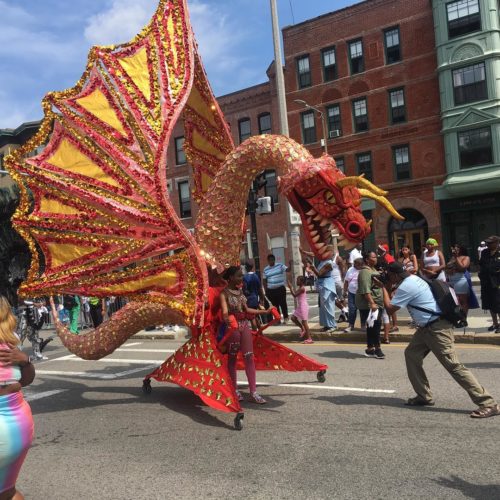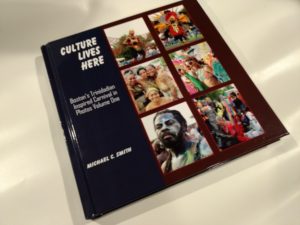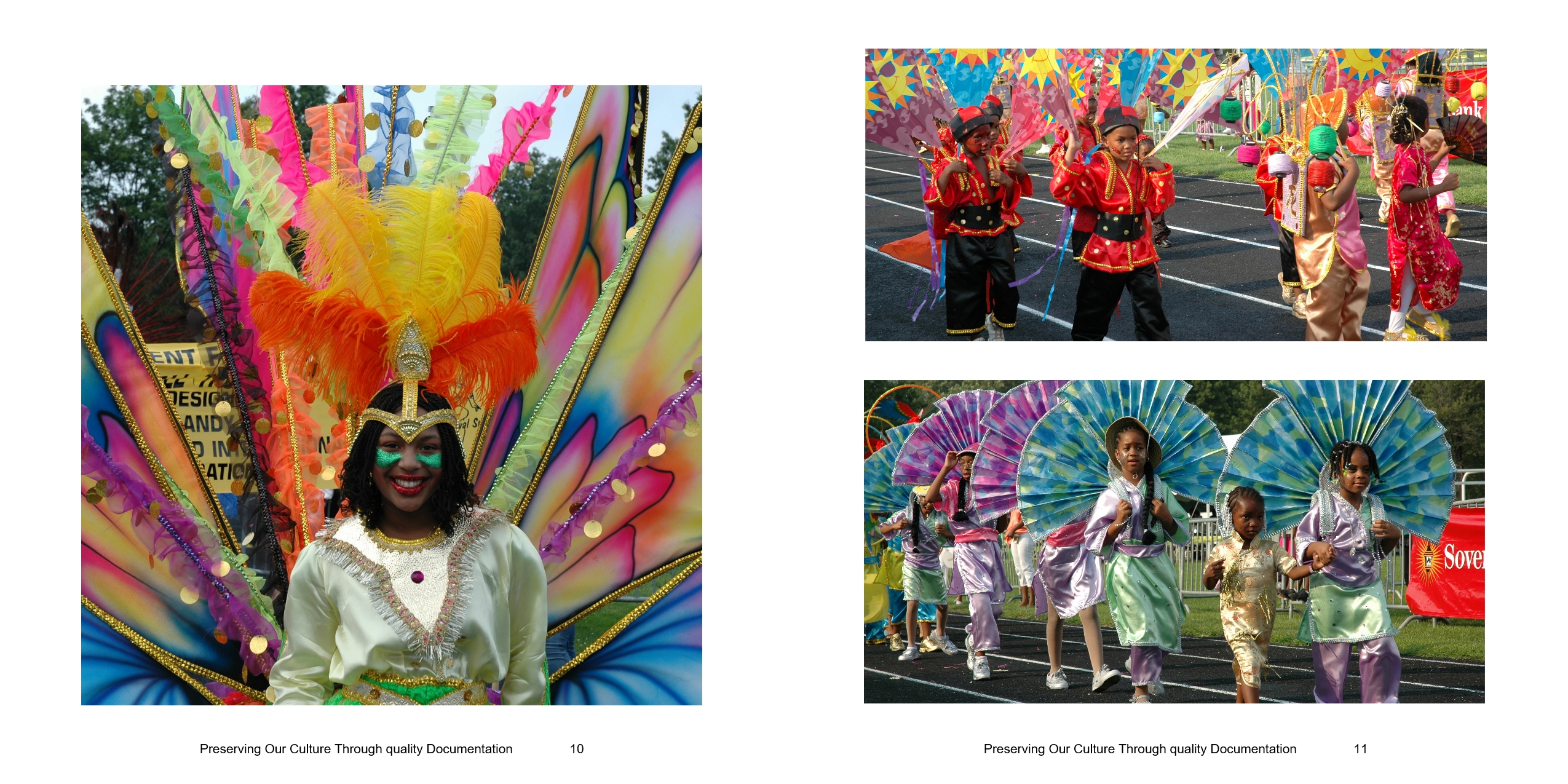Music Interview: Michael C. Smith on the Boston Caribbean Carnival and How “Culture Lives Here”
By Noah Schaffer
Michael C. Smith’s new Boston Carnival photo book proves that “Culture Lives Here.”

Michael C. Smith in action photographing the Boston Caribbean Carnival parade. Photo: Noah Schaffer.
This Saturday is the annual Boston Caribbean Carnival. Two things are guaranteed at both the early morning J’ouvert and the afternoon parade. One is that there will be an abundance of color, costumes, music, and culture. The other is that Boston cultural activist Michael C. Smith will be right in the thick of the mix taking photos.
Smith has now compiled his years of Carnival photos into a lavish photo book called Culture Lives Here. He recently talked to Arts Fuse about the volume, the state of Boston Carnival, and his annual J’ouvert Face Mask boat ride which will be held on Friday night.
Arts Fuse: Talk about your background.
Michael C. Smith: I’m originally from the Caribbean island of Trinidad and Tobago. I came here via the US Virgin Islands from New York. How I came to Boston was sort of an accident. My uncle was a mechanic at an airport in New York City and they transferred him to Boston. I then prepared to go to college; I was accepted to Northeastern University and that’s where I spent the next five years. I got a bachelors’ degree in engineering technology. But I began to do different things that interested me, and among them was photography. I didn’t attend a photography class in college, so after I graduated I took a correspondence course from the New York Institute of Photography. That only increased my interest. I never wanted to do it as a living — I’m not a professional photographer. What I shoot, I shoot for me.
So while all those things were going on a friend suggested that I become part of the Caribbean Carnival Association. I resisted that for years, but eventually I joined up. And that turned out to be a disaster because I didn’t like what they were doing. There were no plans and there are still no plans. So after years of frustration and fighting they eventually kicked me out of the organization, which has turned out to be a heaven-sent thing for me. The Association had no website for the Carnival, so I put something up so there would be an outlet for information. That website evolved into what my website BostonCarnivalVillage.com is today.

A look a couple of pages in “Culture Lives Here.”
AF: How did the book come about?
Smith: Something told me to start documenting the Carnival. So I walked from one end of the parade route and photographed everything that caught my eye. And those images turned into an exhibit at Lesley University. And then I did another exhibit, and out of that came the book Culture Lives Here. I looked at over 20 years of images for this book. I examined coffee table books because I wanted something people would be proud to put in their living rooms and show to their friends. I decided to start from 2005. A lot of of the work from 2004 on back was on film; converting negatives to what I could use in the book was too time intensive. So I categorized the images by year and then each year subdivided them into the Kiddie Carnival, J’ouvert, and what we call the street parade. Then I selected images I thought best illustrated the history of the Carnival, that gave a sense of its culture and beauty. I see the Carnival as living art.
AF: Is the book made up entirely photos?
Smith: No, I also have some text. For example, every year I used to go early to the mas camps [home bases for Carnival bands] and observe how the costumes were made. There you saw people cutting and sewing material, gluing things together. Eventually people put on their costumes and marched in the parade. I document what is involved in putting these big costumes together. People will marvel at the photographs, and then read short (500 to 600 word) sections that I have written on costuming and other aspects of the Carnival. The biggest problem I had in putting the book together was documenting the Kiddie Carnival — I didn’t want to leave anyone out. You see the children with their parents, who are explaining to them what the culture is all about.
AF: How have you seen Carnival change since you’ve been documenting it?

A copy of Michael C. Smith’s “Culture Lives Here.”
Smith: I hope this book puts some pressure on the Carnival organizers, because these people are clueless. Boston Carnival should own the month of August. We should have a whole boatload of cultural activities taking place throughout the month, culminating with the parade. And that is not happening. Today we’re in a situation, sadly, where things seem to be going downhill. We used to have 20 to 30 bands — now we only have three or four traditional bands in the parade, which I think is sad. There used to be hundreds of buses coming from across the state and New York to the parade — now you are lucky if you can find one or two buses. This morning got a call from a guy in New York who was trying to bring in a bus — and he had no takers. I was shocked to look back at the number of steel bands that used to be part of the Carnival. Once we had over 11 steel bands in this town — today we barely have one or two.
The organizers are not doing anything to move the Carnival forward and grow. They just get the permits from the city. Whatever band shows up shows up; nothing is set up to help people start their own band or to teach them how to make their own costumes. None of those things are going on. A lot of people tell me it’s a good thing I have a website because otherwise the Boston Carnival would be moribund. Anything this book does to force change would make me very happy. I will use this book to talk to people about the history of the Boston Carnival. The book will show them how important it is, and show the transition from 2005 to 2015, the changes in terms of the quality of the costumes and number of bands.
AF: Is it hard to take photos during a Carnival? It’s a moving event, you can’t have people just stand and pose.
Smith: I am one of those photographers that cannot stand up in one place. I usually get to the start of the parade and start taking my pictures from there. After I’ve captured the last band I’ll start walking back up the street and try to get more intimate shots of the musicians. I cannot stand in one fixed position and take photos, I find that boring. it doesn’t tell a dramatic enough story for me — I have to move with the bands back and forth and take as many images as I can. I’ll worry about post-production later. The route is about 1 mile long and when the bands are coming up the street I try to capture all I can with my camera. I will judge what I have taken when I get home. For me, that is the joy of photography. I hate people modeling or posing, I can’t stand that. You do what you’re doing and pretend I’m not there. I’ll do the rest; that tells a better story.
AF: At one point you were one of a very small handful of people documenting Carnival. Now everyone is taking photos and videos with their phones. Has that changed the Carnival vibe?
Smith: I’m not quite sure. They don’t have the fundamentals down in terms of holding a camera and taking a shot. They don’t know how to move the camera from A to B. So what you see on the internet is someone zooming in on someone dancing for 2 seconds. They move on or they may take a selfie — and that’s about it. Those images may stay on their phone or their Facebook page for a few days, and then they are history. People move on. For me, it’s important to document the Carnival and to get things right. I will take pictures of people who are not in the parade — they’re just observing and watching the bands go by. But they may have an expression on their faces I find interesting, and I want to capture that too. I’m trying to capture the whole package, to be able to tell the story in a photo essay.
I will shoot a lot of images this weekend and all those will sit in my memory card this winter and then I’ll go through and pick out the ones I find interesting. I’ll put something on my Facebook page so people can have a quick look back, and then I archive it, for purposes such as this book. If I get a call from London asking for something on Boston Carnival I’ll be able to send images off to them. I tell my kids ‘You’re going to have to deal with this when I kick the bucket.’ [Laughs] This is history that should not be destroyed. As far as I know, mine is the first coffee table book in North America on the Carnival. Hopefully, this will stimulate other people to do other things as well. Documenting this culture is so important. I write in the book that it is about “Preserving our culture through quality documentation.”

Another look at “Culture Lives Here.”
AF: One of your other major endeavors is the annual J’ouvert Face Mask Cruise, which takes place the night before Carnival. How did that come about?
Smith: Around 2005 I did a survey about who was coming to Boston Carnival. One of the things I found out is that when people came ,they stayed in a hotel. They had no idea whether there’s was anything else going on. They were staying in their hotel by themselves, going to the parade, and then going home. Some of these hotels were booked solid — and they had no idea why! So I decided to create an activity — a boat cruise in Boston Harbor. People could come into Boston, see Faneuil Hall, and later that night jump on a boat, go out in the harbor, enjoy some music, have some food, and have a good time. At first we just called it the J’ouvert Boat Cruise. But then I realized other promoters were starting up J’ouvert events and other boat rides. So we went with a tradition in Trinidad, in which you wear a face mask, as if you are attending a costume ball. The cruise been growing steadily every year.
Over the past 15 years Noah Schaffer has written about otherwise unheralded musicians from the worlds of gospel, jazz, blues, Latin, African, reggae, Middle Eastern music, klezmer, polka and far beyond. He has won over ten awards from the New England Newspaper and Press Association.
Tagged: Boston Caribbean Carnival, Boston Carnival Village, Culture Lives Here, J’ouvert Face Mask boat ride

Good thing some one like Michael C. Smith is working for the heritage of his native culture. Keep it up Mike
Thank you Preserving our culture through quality documents is very important to me